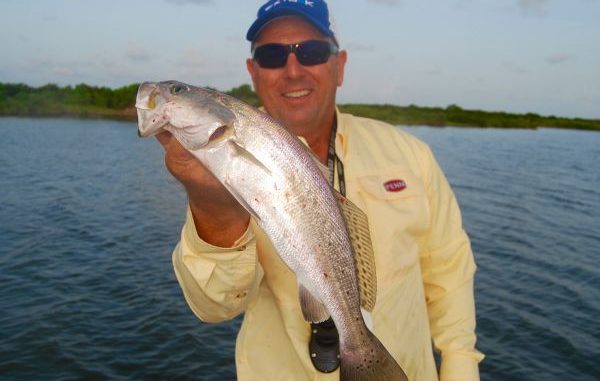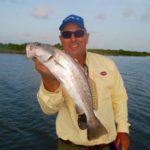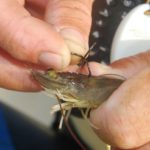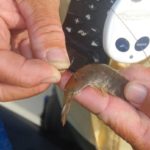
Fish shallow sand flats and points protected from the wind, Pellegrin said
Capt. Tommy Pellegrin would typically be patrolling the beach side of Timbalier Island in early July, looking for birds diving and shrimp jumping to target speckled trout out of Cocodrie.
But Mother Nature has thrown anglers a curveball this summer, and the weather — especially the persistent southerly winds — have been anything but typical.
“It’s been rough, with 10 to 15 mph winds everyday,” said Pellegrin, who owns Custom Charters out of Houma. “The trout are still there, but you’re having to fish differently because of the wind.”
With the beach side of the island a no-go because of the seemingly non-stop wind and rough water, Pellegrin is still targeting specks on Timbalier — but he’s focusing on the back side of the island.
“In early July, the sand flats and points behind the island have big trout sitting up there foraging on shrimp and mullet,” he said. “You can watch mullet get busted and shrimp get chased down on these sand flats in 1 1/2 or 2 feet of water, so you’ve got to fish shallow.”
On a trip Tuesday morning out of Harbor Light Marina on Highway 56, Pellegrin’s 24-foot Skeeter plowed headlong into the waves whipped up by a steady 16 mph south wind as the sun rose over Terrebonne Bay. But at Timbalier Island, conditions were just as he described, with live shrimp under a sliding cork doing most of the damage in calm conditions.
“In July out of Cocodrie, it’s all about the shrimp transition,” Pellegrin said. “The brown shrimp are coming out of the marshes and going to the Gulf. They’re just about totally out of the marsh and they’re around the island, and so you’ve got birds diving, shrimp jumping — a whole lot of stuff is going on. Mackerel, white trout, speckled trout, redfish — everything is hitting these shrimp.
“So for the first half to three-quarters of the month, you want to make sure you have your live shrimp or shrimp imitations, like the PowerBait Rattle Shrimp by Berkley.”
But with the brunt of the summer heat still to come, Pellegrin cautioned that bite wouldn’t last much longer.
“Right now, the water temperature hasn’t gotten too hot and it’s just so easy to fish. You don’t usually get big schools, but it’s typically a slow steady bite of bigger fish. The smaller schoolie stuff is not going to be up on the flats, just the larger fish,” he said. “And if you get a calm day, topwaters will tear it up pretty good, too.
“But once the water heats up, those fish are going to head out for deeper water.”
With water temperatures reaching 84 degrees by late morning, the bite was steady for the most part with some quality trout in the 14- to 18-inch range, and only minor interference from catfish and croakers. One final stop at a wellhead in Terrebonne Bay produced solid trout under a deeper sliding cork, upping the day’s take to 55 specks for three fishermen in non-stop 15 mph winds.
“The trout bite this year has been downright awesome out of Cocodrie — unbelievable,” Pellegrin said. “Lots and lots of fish, and nice-sized fish. Terrebonne Parish, Timbalier Island, Last Island and this area are not known for huge fish, but it’s known for numbers, and the numbers have been there with 12- to 20-inch fish.”
Pellegrin fishes with 30-pound Spiderwire braid connected by a uni-to-uni knot with a 2- to 3-foot Berkley ProSpec 30-pound mono leader, which has either a No. 3 or 4 Mustad KVD Ultrapoint treble hook on its business end. (He hooks the shrimp either through the horn or in the last joint of the tail, depending on how he grabs them from his livewell.)
“The deal with a treble hook is it’s a small profile. You’re putting it in a shrimp that’s got a barb — he’s got a point on his tail and a point on top of his head,” he said. “So the trout expects a point, but it doesn’t expect a long-shank point like a kahle or wide gap hook will have.
“So with the smaller treble hook, they can eat it and it’s down in there throat, and typically it won’t come out. The wide gap hooks usually hook in the lip, and that’s where they tear out more. But if you fish trebles, you’re going to definitely need pliers to get them out of their throat.”
He especially likes the combo of the treble paired with the longer leader for live shrimp.
“I like the long leader because that way the shrimp can move and jump,” he said. “With a short leader, he can’t do too much. But with a longer leader, he’s almost swimming free.
“On a 3-foot leader, he’s in the zone swimming, jumping and do whatever shrimp do to run away. And all that does is attract fish — they just can’t stand it.”





